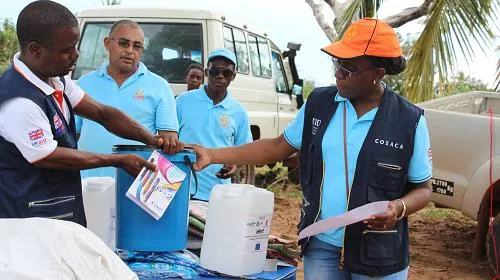(MAPUTO, 5 April 2018) – Following the devastating impact of Cyclone Dineo in February 2017, CARE Mozambique, in cooperation with the government of Inhambane province, recently completed the rebuilding of 163 classrooms for more than 14,000 students. CARE also repaired nine of the province’s most severely damaged health centers, serving approximately 120,000 people.
February 15 marked the one-year anniversary of Cyclone Dineo, which caused havoc in Inhambane affecting more than 550,000 people. Across the province, an estimated 1,600 classrooms were damaged or completely destroyed, affecting 5,500 teachers and 160,000 students.
Immediately after the cyclone, CARE provided 50 temporary classrooms and repaired damaged roofs ensuring lessons continued for around 4,500 students. But with climate shocks becoming more frequent in Mozambique, a long term solution was needed. New classrooms and health centers were built with resilient materials, ensuring they are able to withstand future events.
“While the design and use of a more resilient roof structures necessitated greater construction time, we’re confident that the new roofs will be able to withstand similar cyclones in the future. The existing designs provide a blueprint for roof construction in the area,” noted Marc Nosbach, CARE Country Director in Mozambique.
“We know that Mozambique will face similar weather events in the future, so CARE worked closely with the provincial government to ensure that the rehabilitated structures are more resistant to cyclones and to reduce the impact on students and teachers,” added Nosbach.
During the immediate aftermath of Cyclone Dineo, CARE provided emergency kits containing tarpaulins, blankets, mosquito nets and household items, as well as chlorine tablets to ensure clean water for people in affected locations. Emergency response and rehabilitation activities were financed with support from Irish Aid, ECHO, DFID, Canadian Humanitarian Assistance Fund, UNICEF, USAID and the US Embassy in Maputo.
“We’re very grateful to CARE and its partners for their work rehabilitating so much of the infrastructure damaged and destroyed by Cyclone Dineo. The rehabilitation of the classrooms will benefit the children who are studying at schools, and it’s been possible to provide the maximum comfort to our students. The repaired and rebuilt health centers will benefit many people in the districts of Massinga, Morrumbene and Maxixe,” said Cândido Sinai Mapute, the Deputy Coordinator for Emergency Operations Centers, Inhambane province.
In Inhambane, CARE continues to focus on improving food security and nutrition, fostering greater resilience among smallholder farmers. As part of CARE´s long term focus on emergency response, the organization has expanded its work in the sectors of disaster risk reduction and climate change. CARE is a member of the COSACA consortium, which delivers emergency and large-scale humanitarian assistance to Mozambican communities affected by disasters.

